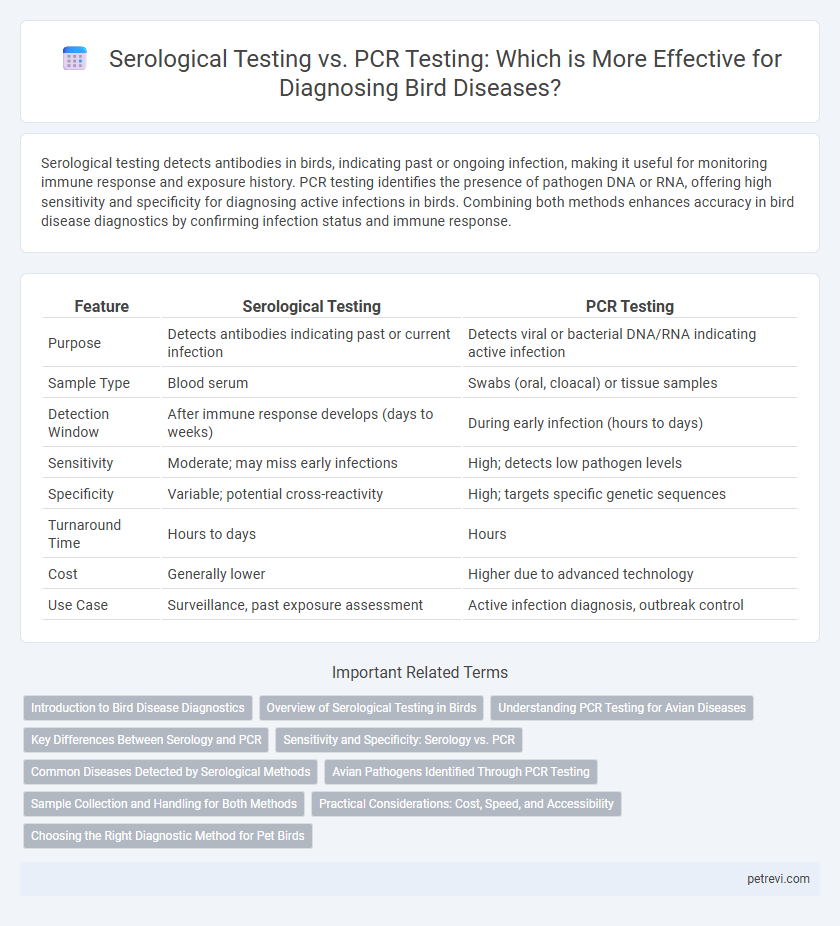Serological testing detects antibodies in birds, indicating past or ongoing infection, making it useful for monitoring immune response and exposure history. PCR testing identifies the presence of pathogen DNA or RNA, offering high sensitivity and specificity for diagnosing active infections in birds. Combining both methods enhances accuracy in bird disease diagnostics by confirming infection status and immune response.
Table of Comparison
| Feature | Serological Testing | PCR Testing |
|---|---|---|
| Purpose | Detects antibodies indicating past or current infection | Detects viral or bacterial DNA/RNA indicating active infection |
| Sample Type | Blood serum | Swabs (oral, cloacal) or tissue samples |
| Detection Window | After immune response develops (days to weeks) | During early infection (hours to days) |
| Sensitivity | Moderate; may miss early infections | High; detects low pathogen levels |
| Specificity | Variable; potential cross-reactivity | High; targets specific genetic sequences |
| Turnaround Time | Hours to days | Hours |
| Cost | Generally lower | Higher due to advanced technology |
| Use Case | Surveillance, past exposure assessment | Active infection diagnosis, outbreak control |
Introduction to Bird Disease Diagnostics
Serological testing for bird disease diagnostics detects antibodies indicating previous exposure, offering insights into immune status and population exposure rates. PCR testing identifies specific pathogen DNA or RNA, providing rapid and accurate detection of active infections in individual birds. Combining serological and PCR methods enhances diagnostic accuracy, aiding effective disease management and control in avian populations.
Overview of Serological Testing in Birds
Serological testing in birds detects antibodies against specific pathogens, providing evidence of past or current infections and immune response status. This method is valuable for screening avian populations for diseases such as avian influenza, Newcastle disease, and psittacosis, allowing monitoring of exposure history even when active infection is absent. Serology complements PCR testing by offering insights into the bird's seroconversion and herd immunity rather than direct pathogen detection.
Understanding PCR Testing for Avian Diseases
PCR testing for avian diseases detects viral or bacterial DNA/RNA with high sensitivity, enabling early and accurate diagnosis even in asymptomatic birds. This molecular technique surpasses serological testing by identifying active infections rather than immune responses, crucial for managing outbreaks in poultry and wild birds. Rapid PCR results facilitate timely interventions, improving disease control and preventing widespread transmission.
Key Differences Between Serology and PCR
Serological testing detects antibodies in bird blood, indicating past exposure or immune response to pathogens, while PCR testing identifies the genetic material of the pathogen, confirming current infection. Serology is useful for monitoring population immunity and disease prevalence, whereas PCR provides rapid and highly specific diagnosis during active disease outbreaks. PCR testing requires sophisticated laboratory equipment and has higher sensitivity, whereas serological tests can often be performed more quickly and cost-effectively in field conditions.
Sensitivity and Specificity: Serology vs. PCR
Serological testing for bird diseases detects antibodies, offering high specificity but variable sensitivity depending on the infection stage and antibody levels. PCR testing identifies viral or bacterial DNA/RNA, providing superior sensitivity and early detection even before antibody production, with high specificity driven by primer design. Combining serology and PCR improves diagnostic accuracy by balancing serology's antibody response insights with PCR's molecular detection capabilities.
Common Diseases Detected by Serological Methods
Serological testing in birds primarily detects antibodies against common viral diseases such as Avian Influenza, Newcastle Disease, and Infectious Bronchitis, providing evidence of prior exposure or immune response. These methods are crucial for monitoring flock immunity and disease prevalence in poultry populations. Unlike PCR testing, which identifies active infections by detecting viral genetic material, serological assays offer insights into the bird's immune status and vaccination efficacy.
Avian Pathogens Identified Through PCR Testing
PCR testing identifies avian pathogens by detecting the genetic material of viruses and bacteria such as Avian Influenza Virus, Newcastle Disease Virus, and Mycoplasma gallisepticum with high sensitivity and specificity. Serological testing measures the bird's antibody response to infections but cannot confirm active infections or pathogen presence. PCR testing enables early diagnosis and precise identification of avian disease agents critical for effective disease management and control.
Sample Collection and Handling for Both Methods
Serological testing for bird diseases requires careful collection of blood samples, usually via venipuncture, ensuring minimal hemolysis and proper storage to maintain antibody integrity. PCR testing demands precise collection of swabs or tissue samples, often from the respiratory or digestive tract, with immediate preservation in RNA stabilizing solutions to prevent nucleic acid degradation. Both methods necessitate strict adherence to sterile techniques and rapid transport under controlled temperatures to ensure accurate diagnostic outcomes.
Practical Considerations: Cost, Speed, and Accessibility
Serological testing for bird disease diagnostics is generally more cost-effective and accessible, providing quicker results by detecting antibodies, which is beneficial for large-scale screenings. PCR testing, while more expensive and requiring specialized equipment, offers higher sensitivity and early detection by identifying viral DNA or RNA in bird samples. Farmers and avian veterinarians often balance the choice based on resource availability, urgency of diagnosis, and the specific disease targeted.
Choosing the Right Diagnostic Method for Pet Birds
Serological testing identifies antibodies to determine past exposure to avian diseases, providing insights into immune response in pet birds, while PCR testing detects active infections by amplifying specific pathogen DNA or RNA, ensuring early and accurate diagnosis. For pet bird owners and veterinarians, selecting PCR testing is crucial when immediate treatment decisions are needed, especially for diseases like avian influenza or Psittacosis, where active infection status impacts transmission risk. Serological tests serve as valuable tools for monitoring vaccination efficacy and long-term bird health, making both methods complementary in comprehensive avian disease management.
Serological testing vs PCR testing for Bird disease diagnostics Infographic

 petrevi.com
petrevi.com